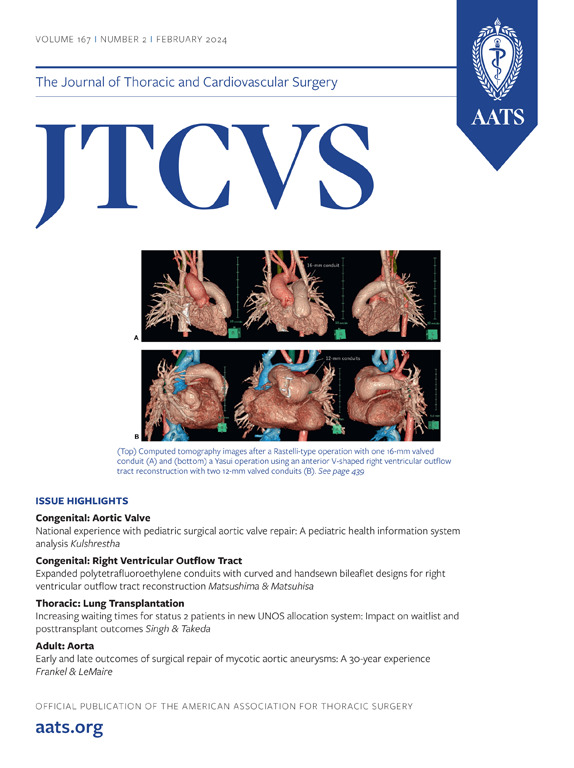Optimal circulatory arrest temperature for total aortic arch replacement: Outcomes of neurological complications
IF 4.4
1区 医学
Q1 CARDIAC & CARDIOVASCULAR SYSTEMS
Journal of Thoracic and Cardiovascular Surgery
Pub Date : 2025-10-01
DOI:10.1016/j.jtcvs.2024.11.034
引用次数: 0
Abstract
Objective
The optimal hypothermic circulatory arrest temperature during total arch replacement and the impact of hypothermic circulatory arrest temperature on postoperative neurological complications are still uncertain. The aim of this study is to explore the impact of hypothermic circulatory arrest temperature on short-term postoperative outcomes, especially neurological complications, for patients who undergo total arch replacement.
Methods
We retrospectively analyzed data of 2351 patients who underwent total arch replacement at 1 of 7 selected aortic centers from January 2016 to June 2023. Restricted cubic splines and subgroup analyses were performed to determine the relation between temperature and outcomes under different cerebral perfusion methods, cannulation strategies, diagnoses, and surgical timings.
Results
The overall in-hospital mortality was 6.2% (n = 146). The incidence of stroke, paraplegia, and total-arch composite outcome was 6.0% (n = 142), 2.8% (n = 65), and 21.0% (n = 494), respectively. The average hypothermic circulatory arrest temperature was 25.9 °C ± 1.9 °C, and the median circulatory arrest time was 23 minutes (Q1, Q3: 18, 30). Adjusted restricted cubic splines showed the lowest incidence of stroke, paraplegia, and total-arch composite outcome at temperatures of 26.6 °C, 27.4 °C, and 26.8 °C, respectively, but without statistical significance. In subgroup analysis, the unilateral antegrade cerebral perfusion group revealed a significant nonlinear relation between the hypothermic circulatory arrest temperature and the risk of stroke, and the lowest risk was at 26.5 °C. Other subgroup analyses did not reveal a significant nonlinear relation between temperature and outcomes.
Conclusions
For patients undergoing total arch replacement with unilateral antegrade cerebral perfusion, cooling to a temperature of 26 °C to 27 °C was associated with the lowest incidence of stroke.
全主动脉弓置换术的最佳循环停止温度:神经系统并发症的结果。
背景:全弓置换术(TAR)中最佳的低温循环停止(HCA)温度以及HCA温度对术后神经系统并发症的影响尚不确定。目的:本研究的目的是探讨HCA温度对TAR患者术后短期预后,特别是神经系统并发症的影响。方法:我们回顾性分析了2016年1月至2023年6月在七个主动脉中心之一接受TAR治疗的2351例患者的数据。采用限制性三次样条(RCS)和亚组分析来确定不同脑灌注方式、插管策略、诊断和手术时机下温度与预后的关系。结果:住院总死亡率为6.2% (n = 146)。卒中、截瘫和全弓复合结局(TCO)的发生率分别为6.0% (n = 142)、2.8% (n = 65)和21.0% (n = 494)。HCA平均温度为25.9±1.9°C,中位循环停止时间为23 (Q1, Q3: 18, 30) min。调整后RCS显示,26.6°C、27.4°C和26.8°C时卒中、截瘫和TCO发生率最低,但无统计学意义。在亚组分析中,单侧顺行脑灌注(uACP)组HCA温度与卒中风险呈显著非线性关系,26.5℃时风险最低。其他亚组分析没有揭示温度和结果之间的显著非线性关系。结论:对于接受TAR治疗的uACP患者,降温至26-27°C与卒中发生率最低相关。
本文章由计算机程序翻译,如有差异,请以英文原文为准。
求助全文
约1分钟内获得全文
求助全文
来源期刊
CiteScore
11.20
自引率
10.00%
发文量
1079
审稿时长
68 days
期刊介绍:
The Journal of Thoracic and Cardiovascular Surgery presents original, peer-reviewed articles on diseases of the heart, great vessels, lungs and thorax with emphasis on surgical interventions. An official publication of The American Association for Thoracic Surgery and The Western Thoracic Surgical Association, the Journal focuses on techniques and developments in acquired cardiac surgery, congenital cardiac repair, thoracic procedures, heart and lung transplantation, mechanical circulatory support and other procedures.

 求助内容:
求助内容: 应助结果提醒方式:
应助结果提醒方式:


